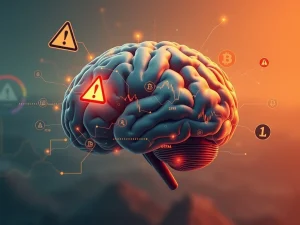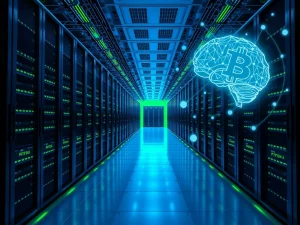Unlocking Stability: Can Artificial Intelligence Truly Prevent the Next Financial Crisis?

Could a silent guardian watch over our financial systems, ready to avert disaster before it strikes? The promise of artificial intelligence (AI) sweeping through industries is undeniable, and the world of finance is no exception. But when it comes to preventing something as complex and devastating as a global financial crisis, can we really rely on algorithms and machine learning? Let’s dive deep into the potential and limitations of AI Financial Crisis Prevention and explore whether it’s a realistic hope or just technological hype.
The Rise of AI in Finance: A New Era of Market Stability?
For years, financial institutions have been harnessing the power of AI to enhance various operations. From fraud detection and algorithmic trading to customer service chatbots, AI in Finance is rapidly transforming the landscape. But the question remains: can these intelligent systems scale up to tackle the monumental task of predicting and preventing systemic financial meltdowns?
Here’s how AI is currently being used in finance, offering glimpses of its potential for crisis prevention:
- Enhanced Data Analysis: AI algorithms can process vast datasets at speeds and scales impossible for humans. This includes economic indicators, market data, news sentiment, and even social media trends. By analyzing these complex data points, AI can identify subtle patterns and anomalies that might signal emerging risks.
- Predictive Modeling for Financial Crisis Prediction: Machine learning models can be trained on historical financial crisis data to identify pre-crisis indicators. These models can then be used to forecast potential future crises with greater accuracy than traditional methods. Imagine an early warning system that flags escalating risks before they spiral out of control.
- Algorithmic Risk Management AI: AI can automate and enhance risk management processes. By continuously monitoring portfolios and market conditions, AI systems can identify and mitigate risks in real-time, reducing the likelihood of cascading failures.
- Improved Decision-Making: AI-powered tools can provide financial professionals with data-driven insights to make more informed decisions. This can lead to more prudent lending practices, better investment strategies, and overall greater financial stability.
Challenges and Complexities: Why AI Isn’t a Silver Bullet for Financial Crises
While the potential of AI in preventing financial crises is exciting, it’s crucial to acknowledge the significant challenges and complexities involved. Relying solely on AI as a foolproof solution would be naive. Here’s a look at some key limitations:
- Unpredictable Black Swan Events: Financial crises are often triggered by unforeseen events – “black swans” – that are inherently difficult to predict. These could be geopolitical shocks, unexpected policy changes, or novel technological disruptions. AI models, trained on historical data, may struggle to anticipate truly novel and unprecedented events.
- Data Dependency and Bias: AI algorithms are only as good as the data they are trained on. If the historical data is incomplete, biased, or doesn’t accurately represent current market dynamics, the AI’s predictions and risk assessments can be flawed. Furthermore, biases in the data can lead to discriminatory or unfair outcomes.
- Model Complexity and Interpretability: Sophisticated AI models, like deep learning networks, can be incredibly complex and opaque. It can be challenging to understand why an AI system makes a particular prediction or decision. This lack of transparency – often referred to as the “black box” problem – can make it difficult to trust and validate AI-driven risk assessments, especially in high-stakes financial scenarios.
- Regulatory and Ethical Hurdles: The widespread adoption of AI in finance raises significant regulatory and ethical questions. Who is accountable when an AI system makes a mistake that contributes to a financial crisis? How do we ensure fairness and transparency in AI-driven financial systems? Developing appropriate regulatory frameworks and ethical guidelines for Market Stability AI is crucial but complex.
- The Human Element Remains Critical: Financial markets are inherently driven by human behavior, psychology, and emotions. While AI can analyze data and identify patterns, it may struggle to fully capture the irrationality and herd behavior that often fuel financial bubbles and crashes. Human oversight, judgment, and critical thinking remain essential, even in an AI-driven financial world.
Examples of AI in Action: Real-World Applications
Despite the challenges, AI is already making strides in various areas of finance, showcasing its potential for enhancing stability. Here are a few examples:
| Application | Description | Potential Benefit for Crisis Prevention |
|---|---|---|
| Fraud Detection | AI algorithms analyze transaction data to identify and flag suspicious activities, preventing financial losses and maintaining system integrity. | Reduces systemic risk by preventing large-scale fraud that could destabilize financial institutions. |
| Algorithmic Trading Surveillance | AI monitors algorithmic trading activities to detect market manipulation and prevent flash crashes. | Enhances market integrity and reduces the risk of sudden, destabilizing market events. |
| Credit Risk Assessment | AI improves credit scoring models by incorporating a wider range of data points, leading to more accurate assessments of borrower risk. | Promotes responsible lending and reduces the build-up of bad debt that can trigger financial crises. |
| Stress Testing | AI can create more sophisticated and realistic stress tests for financial institutions, simulating various economic scenarios to assess their resilience. | Identifies vulnerabilities in the financial system and allows for proactive measures to strengthen resilience. |
Actionable Insights: Embracing AI Responsibly
So, can AI prevent the next financial crisis? The answer, for now, is a nuanced “not entirely, but it can significantly help.” AI is a powerful tool that can enhance our ability to understand, predict, and manage financial risks. However, it’s not a magical solution. To effectively leverage AI for Risk Management AI and financial stability, we need to take a responsible and balanced approach:
- Focus on Augmentation, Not Replacement: AI should be seen as a tool to augment human expertise, not replace it. Financial professionals should work alongside AI systems, using their judgment and experience to interpret AI insights and make informed decisions.
- Invest in Robust Data Infrastructure: High-quality, diverse, and unbiased data is crucial for effective AI. Investing in data collection, cleaning, and management is essential.
- Promote Transparency and Explainability: Efforts should be made to develop more transparent and explainable AI models, particularly for critical financial applications. Understanding how AI systems arrive at their conclusions is vital for building trust and ensuring accountability.
- Foster Collaboration and Knowledge Sharing: Collaboration between AI developers, financial institutions, regulators, and policymakers is crucial to address the challenges and opportunities of AI in finance effectively.
- Prioritize Ethical Considerations: Ethical principles must be at the forefront of AI development and deployment in finance. Ensuring fairness, transparency, and accountability is paramount.
Conclusion: A Hopeful Future with AI-Augmented Finance
While the dream of a completely crisis-proof financial system might remain elusive, artificial intelligence offers a powerful arsenal of tools to mitigate risks and enhance stability. By embracing AI responsibly, focusing on its strengths while acknowledging its limitations, and combining it with human wisdom and oversight, we can move towards a more resilient and stable financial future. The journey of integrating AI Financial Crisis Prevention is ongoing, but the potential for a safer and more secure global financial system is undeniably within our grasp. Let’s harness the power of AI wisely to build a financial world that is better equipped to weather any storm.









